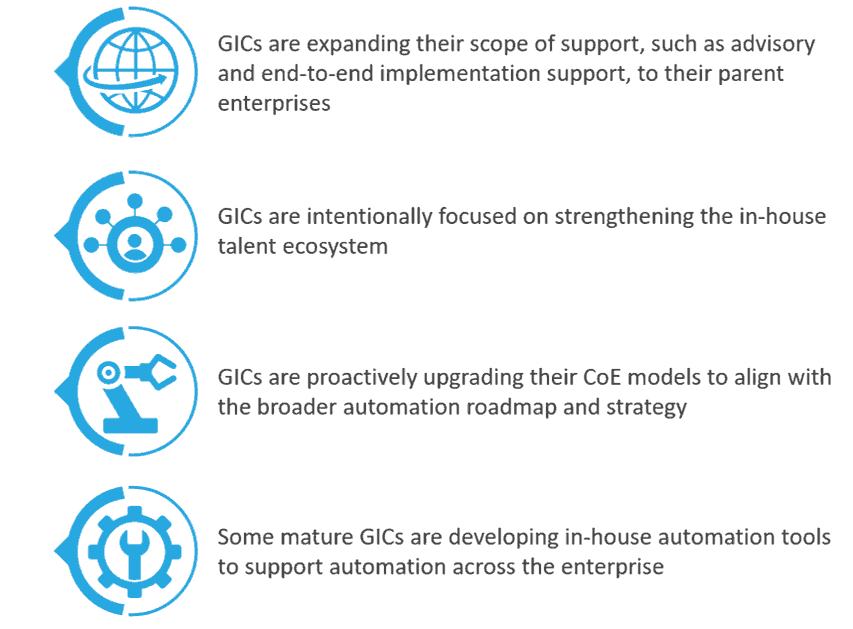Blog
Is Your Shared Services Center Driving Automation Across Your Enterprise? | Blog

Over the past few years, automation has become an integral part of Shared Services Centers’ (SSCs) growth and evolution. Whether large or small, whether onshore, nearshore, or offshore, SSCs – what we refer to as Global In-house Centers (GICs) – have made strong progress in adopting automation solutions.
Some have only dipped their toe into basic RPA. Others have moved ahead with more advanced automation technologies like machine learning and artificial intelligence. And a handful have started emerging as key strategic and revenue-generating entities for their parent companies. These GICs have built scaled delivery teams with strong domain knowledge around the implementation of automation solutions. There are multiple instances of GICs housing the global automation Center of Excellence (CoE) and driving initiatives across the enterprise. Aggressive adopters have moved beyond automating processes within the center and are now supporting process automation across locations and businesses. And they’re increasingly leading the design and execution of automation strategy, and are influencing decisions on go/no-go opportunities.
Everest Group’s recently published report Scaling Up the Adoption of Automation Solutions – The Evolving Role of Global In-house Centers discusses the key adoption trends and challenges in the GIC and automation space.
Let’s take a quick look at the four key trends.

Solutions and support
Some mature GICs have developed multiple offerings to support different businesses. Typical offerings include advisory support, platform or infrastructure support, and end-to-end implementation support. For instance, the India GIC of a leading European insurance firm provides bot infrastructure support to the company’s Singapore entity. With this set-up, the Singapore-based team didn’t have to invest in its own infrastructure to gain full access to the bots’ capabilities.
The talent ecosystem
From developing in-house automation talent to managing vendor resources, SSCs are making major strides in the talent management space. As part of their talent management strategy, many best-in-class GICs are investing heavily in building in-house talent, especially for AI-based solutions. This includes developers, data scientists, and project managers. These GICs are also investing significantly in upskilling/reskilling programs for their resources, and are strongly emphasizing education and awareness of automation’s capabilities and benefits. Some GICs are also training their business/operations resources on automation skills; this helps them scale-up faster.
CoE roles, governance mechanisms, and structures
Many GICs are upgrading their CoE model, roles, and responsibilities as they progress along their automation journey. Many successful centers are moving towards the federated hub and spoke CoE model, wherein the GIC houses the CoE hub and the functions have their own automation team (spokes.) The federated model enables rapid scalability and better opportunity identification than centralized CoEs. But, with either model, there are some pitfalls to avoid. Our blog titled Four Reasons Enterprises Aren’t Getting Full Value from Their Automation CoEs details what they are.
In-house automation platforms
Building on their understanding of automation capabilities, some mature GICs have started exploring the use of custom-built in-house platforms to run automations. While in most cases these are for attended RPA bots, some best-in-class SSCs have developed platforms using advanced technologies such as interactive virtual assistants (IVA) and machine learning. There are even a few examples of GICs adopting a 100 percent in-house development model, meaning no third-party vendor support. While we expect GICs to continue exploring in-house automation tools, we don’t expect that these will replace the use of third-party vendor products in the near future.
What GICs have accomplished over the past few years in scaling up the adoption of automation solutions across businesses and locations is just the tip of the iceberg. Going forward, they are likely to build on this foundation and penetrate deeper into the enterprise with ever more complex automations.
To learn more, please read our report — Scaling Up the Adoption of Automation Solutions – The Evolving Role of Global In-house Centers – or contact us directly at Bharath M or Param Dhar.